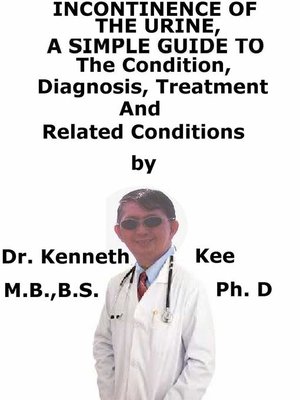Incontinence of the Urine, a Simple Guide to the Condition, Diagnosis, Treatment and Related Conditions
ebook
By Kenneth Kee

Sign up to save your library
With an OverDrive account, you can save your favorite libraries for at-a-glance information about availability. Find out more about OverDrive accounts.
Find this title in Libby, the library reading app by OverDrive.



Search for a digital library with this title
Title found at these libraries:
| Library Name | Distance |
|---|---|
| Loading... |
Urinary incontinence is a symptom and indicates the uncontrollable leakage of urine.This can produce a lot of discomfort to patients having this disorder or symptom.Elderly women are more susceptible to it than men.With a longer life span many elderly patients can be observed being brought to the family doctor clinic wearing adult diapers.Elderly patients are likely to believe that the only way to prevent embarrassment is to wear absorbent menses pads or padded undergarments like adult diapers.However the skin wetness may result in rashes, sores, or infections.Most people with urinary incontinence are women mainly because childbirth weakens the pelvic floor muscles.Old age in turn such as the menopause produce both weakness and other age related disorders which can affect the period of time the patient can wait once the patient feels the urge to goAlcoholism and an enlarged prostate can both produce it as well, but childbirth related muscle weakness remains the most frequent cause.Causes:With aging, the bladders are not capable of holding as much urine and the sphincter muscles may weaken reducing the body's ability to stop the urination.In women the reduction in estrogen after menopause causes the lining of the urethra to be thinner so that it might not close properly permitting urine to leak out.Childbearing can also raise the danger of forming urinary incontinence.With age or after vaginal delivery, the pelvic muscles are never as strong as the way they were before birth, particularly after multiple deliveries.Everyone tend more likely to become incontinent with age because of both the deterioration of the organs and brainWomen have the greater disorder because of childbirth, the menopause and also having a shorter outletOther causes:Diabetes, neurological diseases, and nerve injuryIn men and women, urinary incontinence can be due to neurological disorders such as multiple sclerosis, spinal cord injury, and Parkinson's disease.Pelvic surgery or prostate surgeryEnlarged prostate in menPelvic organ such as uterus prolapse in womenUrinary Incontinence is a medical symptom which may be temporary or permanentUrinary incontinence may be categorized into 4 main types:StressUrgeOverflowFunctionalMixedA full history and physical examination will be able to help the doctor to diagnose urinary incontinence, type and possible causes of the incontinence.UrinalysisPost-void Residual MeasurementUltrasoundUrodynamic TestingPad testsVoid diaryCystoscopyTreatment:A. Lifestyle changes.Scheduled ToiletingDouble VoidingBladder TrainingReducing FluidKegel exercisesVaginal cone therapyBiofeedbackElectrical stimulationB. Treating the cause of the incontinenceMedicinesantidepressantanticholinergicOxybutyninNighttime voiding and incontinenceDesmopressin (DDAVP)PessariesC. SurgeryRemoval of Enlarged ProstateBladder repositioningBladder neck suspensionPeriurethral bulking therapyMid-urethral slingsArtificial urinary sphincterRetropubic suspensionThe transobturator male slingTransobturator vaginal tapeSacral nerve modulationInjection of neurotoxins such as botulinum toxinD. CatheterizationIndwelling urethral cathetersSuprapubic catheterIntermittent CatheterizationMedicated and silver-coated cathetersOther Methods:Absorbent PadsIntra-vesical pharmacotherapyAccupunctureNew Methods:Potassium channel openersProstaglandinsEstrogensUrethral injection of a combined patient-derived adipose stem cells (ASCs) and collagenTABLE OF CONTENTIntroductionChapter 1 Incontinence of UrineChapter 2 CausesChapter 3 SymptomsChapter 4 DiagnosisChapter 5 TreatmentChapter 6 PrognosisChapter 7 Nocturnal EnuresisChapter 8 CystitisEpilogue







